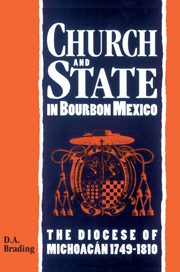9 - Cathedral and chapter
Published online by Cambridge University Press: 01 February 2010
Summary
In 1803 the crown issued a rescript inviting interested parties to submit opinions about the project, formally proposed by the current attorney for the Council of the Indies, Ramón de Posada, to create three new bishoprics in New Spain, respectively based on Veracruz, Acapulco and San Luis Potosí. A former canon of Valladolid cathedral, Manuel de Iturriaga, presented estimates of tithe revenue, in which he asserted that the dioceses of Puebla, Mexico and Michoacán enjoyed a broadly comparable income, ranging from 320,000–360,000 ps. in the 1790s. Once distributed among the bishop and chapter, this revenue yielded stipends of over 6,000 ps. for cathedral canons, a remarkably generous remuneration if it be considered that the twelve intendants who governed New Spain also received 6,000 ps. But Iturriaga, who had resigned his post in order to enter the newly established Oratory at Querétaro, his native city, argued that there was no good reason why these clerics should enjoy such high stipends. The country would be far better served if the tithe revenue was devoted to creating five new dioceses, respectively based on Querétaro; San Luis Potosí at either Córdoba, Jalapa or Orizaba; along the northern coast of Veracruz, including the Huasteca mountains; and along the Pacific coast with a capital at either Acapulco, Chilapa or Chilpancingo. In effect, he accepted Posada's proposals, but suggested cutting the Veracruz province into two dioceses and sought a new bishop for his home city.
The case for a new bishopric was made most forcibly by the city council of San Luis Potosí, which asserted that by reason of its 100 leagues' distance from Valladolid, its residents hardly ever saw their bishop.
- Type
- Chapter
- Information
- Church and State in Bourbon Mexico , pp. 173 - 191Publisher: Cambridge University PressPrint publication year: 1994

